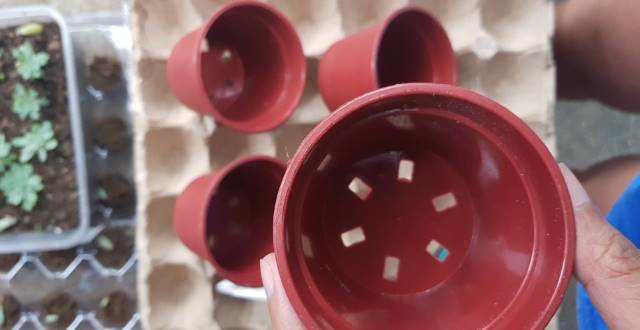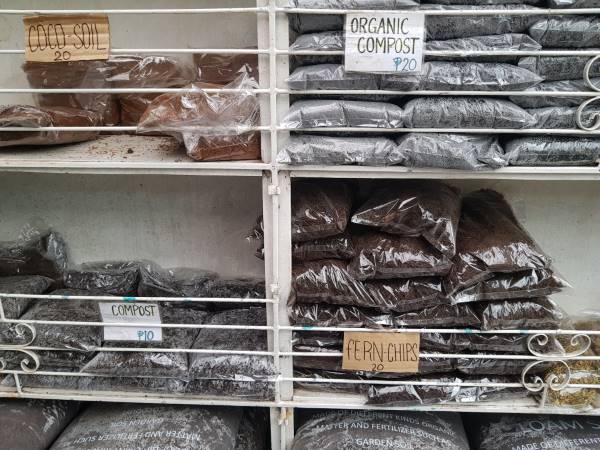Kalanchoe succulents are a genus of over 120 plant species offering a wide variety of foliage and flowers for both indoor and outdoor plantations. Though most species are native to Madagascar, they are popularly grown throughout the world for the ease of maintenance they offer.
Being succulents, they can thrive in arid environments extremely well and live without water for days or even weeks. If you are planning to bring a Kalanchoe home for keeping it indoors, let us find out more about the plant’s requirements.
Can you keep Kalanchoe Succulents Indoors?
Kalanchoes are popular houseplants and, therefore, an ideal choice for indoor plantation. With minimal care and provision of an appropriate indoor environment, Kalanchoes can not only survive but surprise you with their beautiful blooms seasonally. You must, however, prevent your succulents from certain problems they might face when kept indoors.
What are the best Kalanchoes for indoor keeping?
Many Kalanchoe varieties require only a few hours of bright light each day and prevention from harsh direct sunlight. It makes them suitable for indoor keeping. Here are some of the best Kalanchoes for indoor keeping:
Kalanchoe Rhombopilosa
Commonly called Pies from Heaven, Kalanchoe Rhombopilosa is a small succulent reaching just up to 10 to 30 cm in height. The succulent features silvery stems and fan-shaped leaves that are slightly woolly and fleshy.

With a length of just 3 cm, these silver-green leaves with brown markings look like jewels grown in a pot. The succulent grows slowly without much effort from your side. It is beautiful with its unique texture and offers spring bloom in greenish-yellow flowers with reddish lines.
Kalanchoe Pinnata
Often called Air Plant, Miracle Leaf, or Cathedral Bells, Kalanchoe Pinnata is a popular houseplant growing up to 5 feet in height. The succulent features tall, hollow, cylindrical stems bearing fleshy scalloped leaves with reddish margins.

Pinnata is grown for its medicinal value by many people as its leaves have antiseptic and anti-inflammatory properties. Early spring brings clusters of bell-shaped flowers in reddish-purple color on chandelier-like flower stalks.
Kalanchoe Luciae
Kalanchoe Luciae is a small succulent growing up to 2 feet tall. The evergreen plant has smooth, flat, fleshy leaves forming a basal rosette. The paddle-shaped leaves grant this Kalanchoe its popular name – Paddle Plant. The leaves are greenish and bear reddish margins.
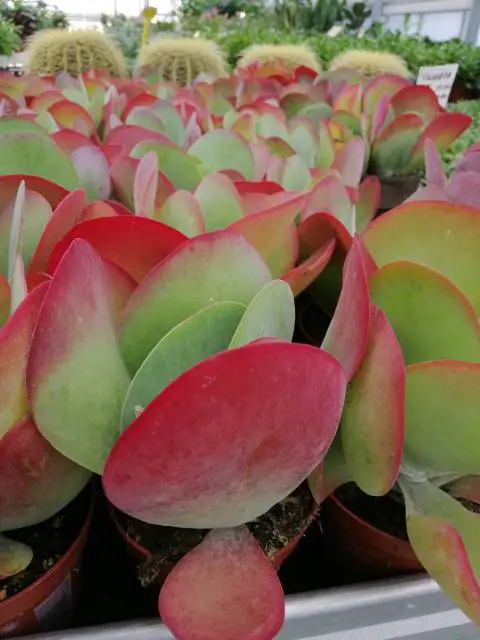
They can beautifully turn completely red in cooler temperatures making them an ideal Kalanchoe to keep indoors. To further enhance the beauty of this succulent, tubular flowers in yellow sprout from their stems in late winter.
Kalanchoe Orgyalis
Kalanchoe Orgyalis is a tree-like taller succulent that can be grown indoors. It can reach up to 6 feet in height but usually remains much smaller than that. Its beautiful velvety copper-colored leaves are spoon-shaped giving this Kalanchoe its popular name – Copper Spoons.

The plant’s other common name Cinnamon Bear comes from the cinnamon-hued hair present on the top of its leaves. Along with the darker places, you can also consider placing Orgyalis in full-sun spots like a sun-facing window as the plant can tolerate high heat pretty well. Beautiful clusters of bright yellow flowers appear at the branch tips in late winter or early spring to further enhance the beauty of this indoor Kalanchoe.
Kalanchoe Blossfeldiana Poelln
Blossfeldiana is probably the most popular Kalanchoe species among plant lovers because of the long-blooming flowers it produces. Commonly known as the Christmas Kalanchoe, the succulent blooms just in time for the holiday season bringing in pretty four-petalled flowers in red, orange, pink, magenta, yellow, and white colors.
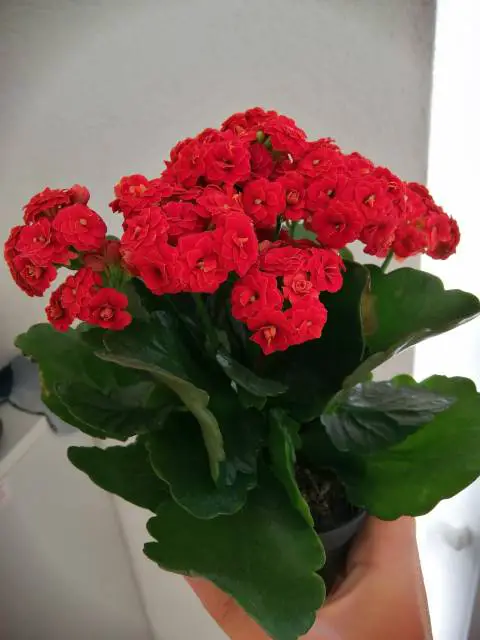
With the height reaching up to 18 inches, Blossfeldiana can be grown in a pot for keeping it indoors. This succulent requires only a few hours of bright light, that too indirect sunlight, for a full bloom. You can enjoy the beauty of its textured glossy foliage as part of your indoor decor.
Kalanchoe Humilis

Humilis is a beautiful Kalanchoe with marble-patterned leaves often used as part of home decor. The succulent grows up to 3 feet tall and features gray-green leaves with maroon, purple, or burgundy stripes. These fleshy egg-shaped leaves arranged in loose rosettes are the main attraction of this decorative succulent. Mid-summer also brings a pretty bloom in the form of small green to dull-purple flowers on 10-inch long stalks arising from the center of the rosette.
Kalanchoe Scapigera
Scapigera is a compact Kalanchoe growing up to 18 inches in height. It features smooth, fleshy, circular leaves that are dull-green or silver-green and bear pinkish edges. Commonly called the Mealy Kalanchoe, the whole plant is beautifully covered with a white powder giving it a unique look. Spring bloom brings tubular salmon-red flowers with yellow stamens adding to the beauty of the evergreen succulent. You can successfully grow this small succulent inside and the ideal indoor placement would be a sunny window for allowing this Kalanchoe to enjoy partial sunlight each day.
Kalanchoe Uniflora
Uniflora is a popular decorative Kalanchoe usually grown in a hanging basket as it is a natural epiphyte. Also called Coral Bell Plant or Trailing Kalanchoe, this succulent bears fleshy bright green to gray-green leaves with reddish margins. Late winter bloom brings bell-shaped flowers in reddish or pinkish color tones. These downward-hanging colorful flowers are its main attraction. Since the plant blooms in winters when the days are short, it is ideal to provide this Kalanchoe limited light. You can keep it indoors in an area that receives filtered sunlight or hang it in a window for letting it absorb indirect sunlight for longer bloom.
Kalanchoe Calandiva

Calandiva is a bushy, evergreen Kalanchoe growing up to 1.5 feet in height. It is a variety cultivated from Kalanchoe Blossfeldiana and is, therefore, scientifically known by the name Kalanchoe Blossfeldiana ‘Calandiva’. The main attraction of this succulent is its rose-like flowers lasting for 6 to 8 weeks. Multiple clusters of double flowers in pink, yellow, red, orange, lavender, burgundy, cream, and white make a beautiful color contrast with its shiny green foliage in winters. When growing indoors, you can always make the bloom last throughout the year by providing your Kalanchoe the appropriate blooming conditions.
Kalanchoe Rotundifolia
Rotundiflia is a beautiful Kalanchoe with fleshy green leaves that might feature orange backs. It grows up to 4 feet in height and requires limited light making it suitable for indoor keeping.
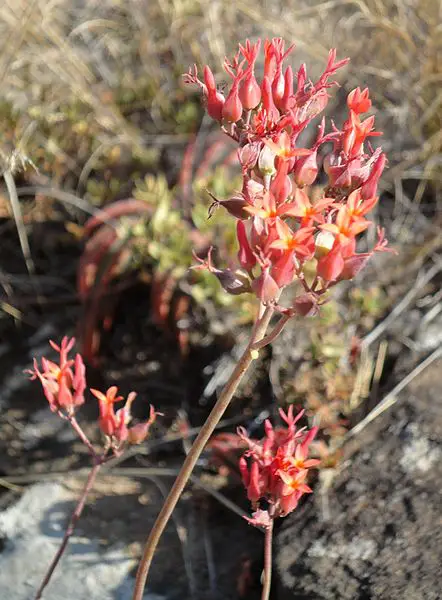
Though this plant is generally grown for its pretty-looking foliage, it also rewards you with seasonal colorful flowers. The succulent blooms in autumn to early winter bringing yellow or orange star-shaped flowers that later turn red.
What are the problems of keeping Kalanchoes indoors?
Ignoring the light and water needs of Kalanchoes might interrupt the survival and growth of your succulent. Here are some aspects that must be considered before planting a Kalanchoe indoor:
Stem rot
Stem rot is the most common problem faced while keeping Kalanchoes indoors. It arises because of excessive watering, high moisture levels, inappropriate soil mix, or water standing in the pot. A well-draining soil mix and letting the upper 2 inches of soil dry in between the waterings will prevent the occurrence of this problem. Also, choosing a pot with holes will prevent waterlogging.
Partial bloom
Indoor Kalanchoe might face a shortage of flowers due to imperfect light conditions. For a full bloom, the majority of Kalanchoe species require about 14 hours of darkness daily for six weeks. The artificial indoor light will interrupt this process and cause a partial bloom. To avoid this problem, consider placing your Kalanchoe in a dark room or closet only to provide it with a few hours of daylight.
Fungus
Some Kalanchoe species might develop powdery mildew fungus when kept indoors. It happens because of improper moisture levels in the environment making it difficult for a succulent to survive. Proper air circulation and sufficient light exposure will prevent this problem.
The good aspect of planting your Kalanchoe indoors is that it is rarely infected by insects or pests. Kalanchoe diseases are most often observed in outdoor plantations. It is, therefore, best to grow your Kalanchoe indoors while keeping the above-mentioned considerations in mind. Also choosing the right variety for indoor keeping will help you enjoy your gardening journey better.
Kalanchoes – The Best Indoor succulents
Almost all Kalanchoe varieties are hardy enough to bear a wide range of temperatures and other conditions. Consider providing adequate lighting and watering to your plant bearing in mind the problems of keeping Kalanchoes indoors. Begin with the above-mentioned Kalanchoe varieties for successfully cultivating the succulent as a houseplant and later try your hand on other Kalanchoe species as you gain experience. Following this route will make your indoor gardening journey a truly satisfying one.


